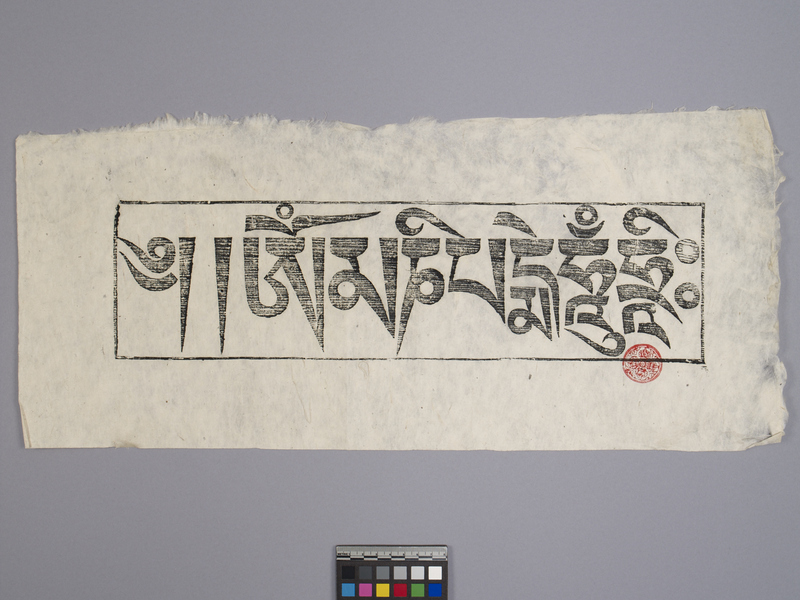Print Item Number: N4.4 from the MOA: University of British Columbia

Description
Rectangle of paper with written prayer printed inside, in black. Round red seal near lower right corner. Paper has raw edges along one long edge and one side.
Iconographic Meaning
A red circular seal on the bottom shows the vajra (thunderbolt or diamond) emblem of Vajrayana Buddhism.
Cultural Context
This woodblock print bears a Tibetan calligraphic inscription of the mantra **||Om mani padme hum hrih, which includes the six sacred syllables of the mantra followed by a seventh tantric syllable at the end. This print was likely produced by hand from a hand-carved woodblock, as one can see the patterned wood grain coming through the pressed ink. The calligraphic text is written in the “headed” or uchen (also transliterated as dbu can) Tibetan script, which is characterized by upright block letters and short horizontal lines (heads) along the tops of many letters. Historically, this type of crisp and angular calligraphy would have been written with a stylus bamboo pen rather than a brush. The bold and graphic script was suitable for formal text and mass printing. The sharp lines are also easily transferred into wood or stone, as is the case here and for many other stone carvings of the same mantra. Such printed images were displayed inside temples and homes, or as framed tourist souvenirs.
Item History
- Made in Nepal
- Collected during 1971
- Owned by Jion Ince before July 22, 1972
- Received from Jion Ince (Seller) and Ruth Read Bequest (Funding source) on July 22, 1972
What
- Name
- Identification Number
- N4.4
- Type of Item
- Manufacturing Technique
- block printed
- Overall
- height 25.2 cm, width 57.1 cm
- Image
- height 12.0 cm, width 44.0 cm
Who
- Culture
- Himalayas
- Previous Owner
- Jion Ince
- Received from
- Jion Ince (Seller) and Ruth Read Bequest (Funding source)
Where
- Holding Institution
- MOA: University of British Columbia
- Made in
- Nepal
When
- Collection Date
- during 1971
- Ownership Date
- before July 22, 1972
- Acquisition Date
- on July 22, 1972
Other
- Item Classes
- works on paper
- Condition
- fair
- Current Location
- Case 76
- Accession Number
- 0230/0001